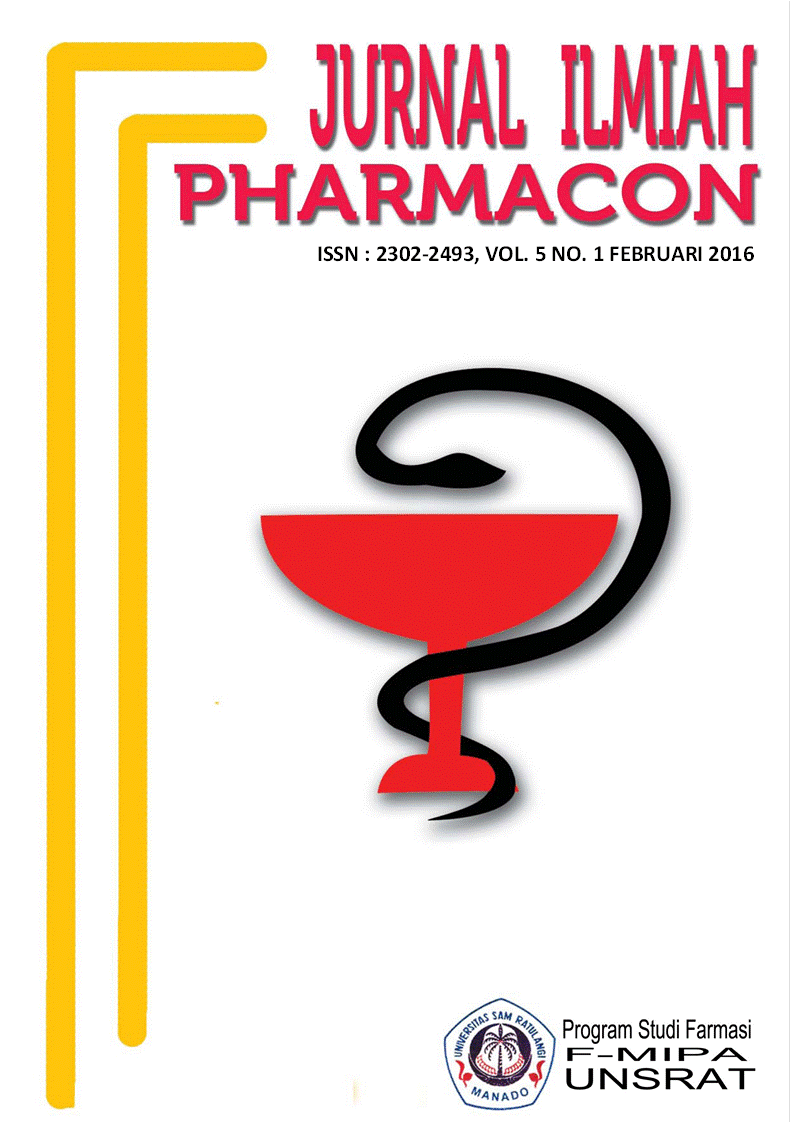UJI EFEK ANTIBAKTERI EKSTRAK KULIT BIJI KAKAO (Theobroma cacao L)TERHADAP BAKTERI Streptococcus mutans
DOI:
https://doi.org/10.35799/pha.5.2016.11219Abstract
UJI EFEK ANTIBAKTERI EKSTRAK KULIT BIJI KAKAO (Theobroma cacao L)TERHADAP BAKTERI Streptococcus mutans
Armiati 1), Michael A. Leman1), Olivia Amelia Waworuntu1)
1)Program Studi Pendidikan Dokter Gigi Fakultas Kedokteran UNSTRAT
ABSTRACT
Dental caries is an oral disease that has a large enough of incidents in the society and one of the dental and oral healty problems are most prominent in Indonesia. The main bacterial cause of dental caries is Streptococcus mutans. The skin is part of the cocoa beans cocoa fruit cocoa bean wraps and is a waste of the chocolate industry. Skin cocoa beans contains antibacterial compounds such as polyphenols, flavonoid. The objectives of this research is to determine the effect of antibacterial skin extract cocoa (Theobroma cacao L) against Streptococcus mutans. This research is experimental research with modified Kirby-bauer method using filter paper. Skin samples of cocoa (Theobroma cacao L) were taken from the city of Manado then ethanol 96%. Streptococcus mutans bacteria taken from a pure stock Microbiology Laboratory, Faculty of Medicene Sam Ratulangi university.The result of this research say that the total diameter of inhibition zone bark extract of cocoa beans against Streptococcus mutans of 97,27 mm with a mean value of 19, 46 mm. That skin extract cocoa beans have an antibacterial effect in inhibiting the growth of Streptococcus mutans bacteria. Inhibition zone bark extract of cocoa beans against the bacteria Streptococcus mutans 19, 46 mm.
Key words : Skin cocoa (Theobroma cacao L ), Streptococcus mutans, Inhibition zone
ABSTRAK
Karies gigi merupakan penyakit gigi dan mulut yang memiliki angka kejadian cukup besar di masyarakat dan salah satu masalah kesehatan gigi dan mulut yang paling menonjol di Indonesia. Bakteri utama penyebab karies gigi adalah bakteri Streptococcus mutans. Kulit biji kakao adalah bagian dari buah kakao yang membungkus biji kakao dan merupakan limbah dari industri coklat. Kulit biji kakao mengandung senyawa yang bersifat antibakteri seperti polifenol, dan falavonoid. Tujuan penelitian ini untuk mengetahui efek antibakteri ekstrak kulit biji kakao (Theobroma cacao L.) terhadap bakteri Streptococcus mutans. Penelitian ini merupakan penelitian eksperimental dengan metode modifikasi Kirby-bauer menggunakan kertas saring. Sampel Kulit biji kakao (Theobroma cacao L.) diambil dari Kota Manado kemudian diekstraksi dengan metode maserasi menggunakan pelarut etanol 96%. Bakteri Streptococcus mutans diambil dari stok bakteri murni Laboratorium Mikrobiologi Fakultas Kedokteran Universitas Sam Ratulangi Manado.Hasil penelitian ini didapatkan total diameter zona hambat ekstrak kulit biji kakao terhadap streptococcus mutans sebesar 97,27 mm dengan nilai rerata sebesar 19,46 mm. Dari penelitian ini disimpulkan bahwa ekstrak kulit biji kakao memiliki efek antibakteri dalam menghambat pertumbuhan bakteri streptococcus mutans. Zona hambat ekstrak kulit biji kakao terhadap bakteri streptococcus mutans 19,46 mm.
Â
Kata kunci: kulit biji kakao (Theobroma cacao L.), Streptococcus mutans, zona hambat.
Â
Downloads
Published
How to Cite
Issue
Section
License
Authors who publish with this journal agree to the following terms:
- Authors retain copyright and grant the journal right of first publication with the work simultaneously licensed under a Creative Commons Attribution-NonCommercial 4.0 International License that allows others to share the work with an acknowledgement of the work's authorship and initial publication in this journal.
- Authors are permitted and encouraged to post their work online (e.g., in institutional repositories or on their website) prior to and during the submission process, as it can lead to productive exchanges, as well as earlier and greater citation of published work (See The Effect of Open Access)










